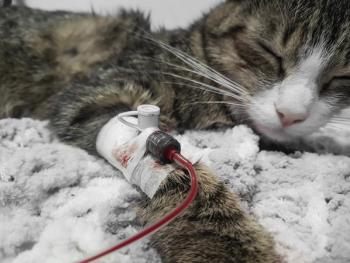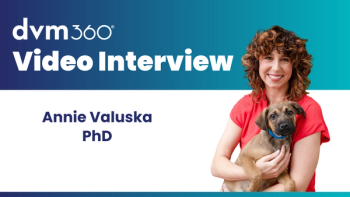
- dvm360 January-February 2025
- Volume 56
- Issue 1
- Pages: 34-35
Relief practice allows veterinarians to thrive
Temporary work is a choice that a growing number of doctors have made in recent years
Relief medicine has risen in recent years and projects an alternative to traditional animal health care practice that is thriving on modern career ideologies and lifestyle culture.
Although relief work may not be the best fit for every practicing veterinarian, it is proving to be a viable career path for many practitioners. Over the course of a decade, ending in 2018, relief practice grew from approximately 1800 veterinarians to approximately 2300 veterinarians, numbers that track with the overall population of practicing veterinarians that is also increasing.1
“What we’re seeing is a shift in how veterinarians approach their careers,” Michael Raphael, CEO of IndeVets, a veterinary relief service provider, said in a dvm360 interview.
Relief veterinary work refers to temporary employment that can range from short- to long-term assignments. Relief doctors support practices by providing patient care and maintaining operational continuity, either through an agency or as independent contractors. They may cover for veterinarians on family leave or vacation, assist with increased workload demands by offering additional expertise, or respond to urgent situations requiring general or specialized skills.
Why professionals choose relief work
In a 2023 survey of relief or mobile veterinarians, for which results were recently released, 444 participants responded, sharing their reasons for making the shift from previous jobs. Administration, hospital culture, leadership, and workplace scheduling were all contributing factors.1
Anita Patel, DVM, director of clinical excellence-southeast for IndeVets, is a mother and relief practitioner in the Atlanta, Georgia, area. She worked as an associate veterinarian in a busy, small animal practice with multiple doctors before pivoting her career to relief practice when she experienced increasing burnout. “I loved the practice I was at, I loved the people that I worked with, I loved the clinical growth that I had, [but] work-life balance just really became something that I wasn’t getting. [I was] constantly feeling like my personal life came second to my professional life,” Patel said.
Like Patel, Raphael said, veterinarians increasingly want to have greater control over their work hours and schedule. “Many feel that traditional associate roles don’t give them that flexibility and respect for life outside of being a vet they need (and deserve). Relief work often seems to be the only viable solution,” he said. “There are many veterinarians who are just looking for a new way to practice. They are looking for a clinically led team where they can grow professionally without the constraints of a traditional associate role.”
Greg Echols, DVM, operates his own relief veterinarian service and recently spoke about it on dvm360’s The Vet Blast Podcast.2 “It feels great,” he said. “I don’t really have to ask for time off. It’s definitely more freedom. It’s less burden [than what I experienced as an associate veterinarian], and [I'm] able to work wherever I want to work.”
Andrew Findlaytor, DVM, was an independent relief veterinarian prior to joining the team at Roo, a digital marketplace for matching veterinarians and technicians with relief jobs, where he now serves as chief veterinarian. He said a desire to keep learning and curiosity for how different hospitals operated led him to relief work. “I figured working in more places would give me more experience, so I set out on this quest to work at every hospital I could find,” he said in a dvm360 interview.
“I found, in my journeys, every hospital has something that they do uniquely well, that no one else has figured out. And every hospital has something they struggle with, no matter how big and fancy or small. Everyone’s got their own thing they’re trying to solve,” Findlaytor added.
The business of relief practice
Although many relief veterinarians rely on service providers like Roo and IndeVets, 210 of 239 respondents of the 2023 survey reported it easy to find relief work, with many citing personal connections, word of mouth, introductions, and personal inquiries as driving sources. Most relief veterinarians surveyed also indicated they have a regular client base of hospitals and shelters.1
Patel said that although it’s nice to have the opportunity to work in different hospitals all the time, it is also good to have her current long-term placement, which has her working in the same hospital every week. “It’s kind of nice sometimes, being able to pick. If I want that continuity and consistency, I can do that, while still getting to practice in a lot of different practices,” Patel said.
Marisa Brunetti, VMD, chief veterinary officer with IndeVets, said she is currently a relief practitioner in a hospital that formerly employed her, and she is enjoying the opportunity to continue engaging with familiar clients and patients. Relief veterinarians who are more interested in practicing across the spectrum of care in a variety of settings from shelter medicine to high-end clinics, like Findlaytor, or who want to primarily work a specialty capacity also find opportunities. “We have lots of doctors that maybe just want to do surgery, and they can't do that every day in one practice. And so they get a chance to do something very specific that they love [through relief work],” Brunetti said.
Compensation for relief veterinarians and technicians varies. How it compares to more traditional roles can even more be tricky to quantify, according to Raphael. “There are so many contributing factors to consider, including out-of-pocket expenses the relief vet must bear, production requirements of the associate, years of experience, and location,” he added.
However, according to Roo, its top-earning relief veterinarians saw more than $300,000 in 2024, with the assumption that they were working at a full-time pace. The average 9-hour shift of a relief veterinarian working through Roo pays $1290, according to the company.3
Although relief service agencies may also offer benefits packages, independent contractors are responsible for securing health insurance on their own, which also factors into compensation variables. However, the latter also has a say in what they are paid. “If there’s a clinic that needs me for a certain number of hours, I can make my own rates,” Echols said in his interview.
Veterinarians working in the relief space also may face potential drawbacks to relief practice. The 2023 study’s authors found new hospital protocols, little support from colleagues, and a lack of job security to be challenges for some respondents.1 Experts also noted that independent relief workers are also spending time securing their next placements and managing administrative tasks such as invoicing, in addition to practicing medicine.
Still, Raphael said hospitals can rely on relief veterinarians to deliver expert medicine. “Oftentimes, this helps those clinics prevent burnout and grow their practices with our highly credentialed vets,” he said.
REFERENCES
- Kogan LR, Rishniw M. Relief and mobile veterinary careers may offer a path towards improved quality of life. J Am Vet Med Assoc. 2023;262(2):209-215. doi:10.2460/javma.23.07.0422
- McCafferty C. From internship to entrepreneurship. dvm360. September 11, 2024. Accessed January 15, 2025. https://www.dvm360.com/view/from-internship-to-entrepreneurship
- Zimmerman R. How much do Roo relief vets make? Roo. December 9, 2024. Accessed January 15, 2025. https://www.roo.vet/roo4you/how-much-do-roo-relief-vets-make
Articles in this issue
10 months ago
Toothaches and triumphs10 months ago
Managing canine oral tumors10 months ago
Understanding anticipatory grief in pet owners10 months ago
Not reinventing the wheel—rethinking it!10 months ago
Power up your dental conversations10 months ago
Managing dystocia with surgery10 months ago
The economics of dental care11 months ago
Hemoperfusion for acute toxin ingestionabout 1 year ago
Managing canine weight with a diet planNewsletter
From exam room tips to practice management insights, get trusted veterinary news delivered straight to your inbox—subscribe to dvm360.




